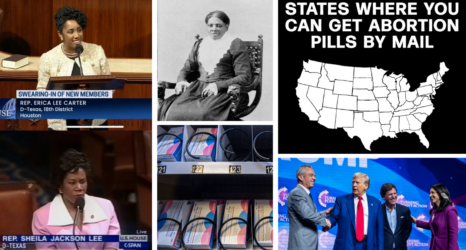Though many called 2018 the “Year of the Women,” the U.S. is far from reaching parity.
There is now a record number of women in Congress—127 of them, to be exact—and in 2018, women filed to run, became party nominees and won against other candidates like never before.
But at the national level, only 25 percent of seats in the U.S. Senate and 23 percent of seats in the U.S. House are held by women. At the state level, women make up only 18 percent of governors and 27 percent of statewide elective executives, and 29 percent of state legislature seats. At the local level, 22 percent of mayors in U.S. cities with populations of 30,000 or more are women.
This is not parity.

The ratification of the 19th Amendment in 1920 granted women the right to vote—but even though, since then, progress and advancements in the representation of women in politics has increased, it is important to keep these advancements in perspective. Existing strategies to increase the number of women in government have only gotten us than halfway to parity, and we cannot wait another 100 years to reach gender parity in elected office.
“Changing rules and systems to create equality is part of the American tradition, and to win gender parity in our lifetimes,” Cynthia Richie Terrell, founder and executive director of RepresentWomen, said in a statement, “we must pivot to system reforms that include gender targets for PACs and political parties so more women run, fair representation voting systems so more women win, and updated legislative practices so more women can serve and lead once elected.”
RepresentWomen understands and acknowledges the importance of training and finding more women candidates, but we also recognize that structural reforms like gender-informed candidate recruitment practices, fair and representative electoral systems and targeted legislative rules will help level the playing field to strengthen and hasten our progress towards gender parity in elected office. That’s why, in 2014, we launched the Gender Parity Index to quantify, identify and track the progress and barriers to gender parity at all levels of government.
How The Gender Parity Index is Calculated
The GPI assigns a grade for each state individually, and the United States as a whole. Calculations are measured on a scale of zero—if no women were elected to any offices—to 100—if women held all elected offices—in order to measure women’s recent electoral successes at local, state, and national levels.
The key advantage of the GPI is that it enables comparisons over time and among states so we can see where we have been and where we currently are in order to inform where we are going. The GPI rates states based on their representation of women at the local, state legislative, state executive and federal levels by assigning each state a letter grade to represent their rating. Our calculations take into account the four most recent U.S. Senate elections, the most recent U.S. House elections, the three most recent gubernatorial elections, the most recent election for all other statewide elected executive offices, the most recent state legislative elections, the gender of their speakers of the state house and state senate presidents, the number of women mayors in all cities with populations of over 30,000 and the county executives in the five largest counties of each state.

The GPI measures political power calculates scores on a weighted, 100 point scale, with 50 points suggesting parity. With the ideal score for each state being 50 points, that would require each state to score 15 out of 30 points in each of the first three sections—U.S. Congress, Statewide executives, and State Legislature—and five out of 10 points in the last section, Cities and Counties. A state will have fully reached parity across all levels of elected government only when 50 points have been achieved.
Inside the 2019 Gender Parity Index
RepresentWomen’s 2019 Gender Parity Index (GPI) is the sixth report in the State of Women’s Representation series that tracks and evaluates women’s representation in all U.S. states and territories. It shows that only 18 states are more than 50 percent of the way to parity, and that the median parity score sits at a low 21 out of 100.

This year, no states were able to achieve parity. Leading the pack were New Hampshire (49.1), Washington (47.4), Maine (43.0), Nevada (42.,3), New Mexico (42.2), Michigan (41.2), California (38.2), Oregon (37.1), Arizona (36.9) and Minnesota (34.4); Utah (8.2), Louisiana (8.4), Montana (10.6), Arkansas (11.3), Texas (11.6), Mississippi (11.7), West Virginia (11.8), Georgia (11.8), Tennessee (12.1) and Vermont (12.2) held the lowest scores.

Regionally, we can see that the West Coast excels in women’s representation while the Midwest and Southeast are lagging behind. The GPI highlights the reality of these geographic trends as a majority of the states with the top 10 gender parity scores are located on the west coast while the bottom 10 scores are mostly located in the southeast.
In 2018, most west coast states were scoring between 25 and 32.9, making them “C” states. The 2019 report shows that these states now score between 33 and 49.9, making them “B” states. The success of the west coast GPI scores compared to the stagnation of midwest and southeast GPI scores show that the gap between the regions is growing larger, and that more needs to be done in these states to support women candidates.

Over the course of this year, the United States has ranked between 77th and 78th in the world for women’s representation in the U.S. House of Representatives.
The Inter-Parliamentary Union has been classifying countries according to the percentage of women in the singular and lower houses of their respective national parliaments and has been doing since 1997. The U.S. ranked 45th out of 179 countries in the world 20 years ago for the percentage of women (13 percent) in the House of Representatives, but at the start of May, the U.S. ranked 77th out of the 192 countries counted.
Almost half of the world’s nations are outpacing the U.S. in women’s representation, largely due to the fact that many of these countries use multi-winner districts and some type of proportional voting- both proven to increase the number of women who are running for and being elected to public office. Mozambique (40 percent), South Africa (45 percent), Spain (47 percent) and Mexico (48 percent) are all still closer to parity than the U.S., and Andorra (50 percent), Bolivia (53 percent), Cuba (53 percent) and Rwanda (61 percent) have achieved gender-balanced of women-led national legislatures.
The 2019 GPI shows that we need to level the playing field for female candidates across the racial, political and geographic spectrum of the United States so more women are able to run and be elected. Our democracy, at every level of government, will benefit and be strengthened by efforts to reach parity—reviving collaborating and bipartisanship, encouraging new styles of leadership and building a greater trust for elected bodies.





